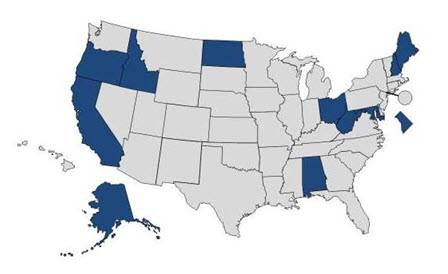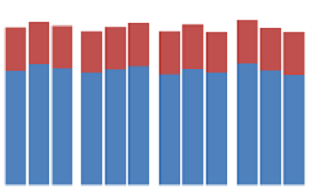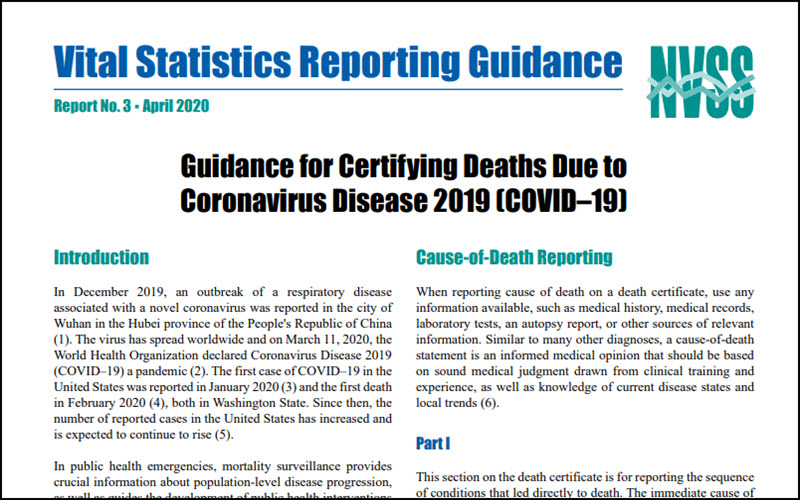COVID-19 Death Data and Resources
NCHS is responding to COVID-19 with new resources to help monitor and report deaths from COVID-19.
Below please find our latest provisional death counts, guidance for filling out death certificates for deaths due to COVID-19, and other important alerts and information.

Tabulated data on provisional death counts for COVID-19 and deaths from all causes, by time-period and jurisdiction of occurrence.
Visualizations of estimates of excess deaths related to the COVID-19 pandemic.
For guidance on completing death certificates, including Guidance for Certifying Deaths Due to Coronavirus Disease 2019 (COVID–19), please visit the Reporting and Coding Deaths Due to COVID-19 page.
Learn more- Expanded Guidance for Certifying Deaths Due to Post-Acute Sequelae of COVID-19 [PDF – 135 KB]
Announcement on the original guidance document being expanded to include guidance on how to properly certify deaths due to PASC.
Released: 2/27/2023 - COVID-19 Certification Guidance and Frequently Asked Questions [PDF – 172 KB]
Announcement for guidance and answers to frequently asked questions about reporting and certifying COVID-19 deaths.
Released: 4/15/2021 - Newly Released Provisional Data: COVID-19 Deaths by Education Attainment and Injury-Related Deaths [PDF – 108 KB]
Announcement about new data releases for COVID-19 deaths by education attainment and monthly injury-related death counts.
Released: 2/3/2021 - Coronavirus Disease (COVID-19) and Pregnancy [PDF – 136 KB]
Pregnancy characteristics and birth outcomes that may be directly or indirectly related to COVID-19
Released: 11/20/2020 - New Guidance for Placement of the ICD-10 code for COVID-19 (U07.1) in NCHS’ standard cause-of-death tabulation lists [PDF – 198 KB]
Announcement detailing where COVID-19 death data will be found in NCHS mortality tables
Released: 9/1/2020 - New Video Guidance for Certification of COVID-19 Deaths and Updated COVID-19 Coding Rules [PDF – 114 KB]
Announcement with new resources and information on certifying and coding COVID-19 on death certificates
Released: 5/5/2020 - Estimates of Excess Deaths Related to COVID-19 [PDF – 110 KB]
Announcement about available data on excess deaths
Released: 4/29/2020 - New Releases: Final Guidance and Provisional Death Counts [PDF – 113 KB]
Announcement for final reporting guidance and data available on deaths due to COVID-19
Released: 4/2/2020 - Notification of new ICD code introduced for COVID-19 [PDF – 150 KB]
Questions and answers about coding COVID-19 on death certificates
Released: 3/24/2020 - Preliminary Guidance for Certifying COVID-19 Deaths [PDF – 171 KB]
Preliminary information for reporting deaths due to COVID-19
Released: 3/4/2020
Provisional death counts deliver the most complete and accurate picture of lives lost to COVID-19. They are based on death certificates, which are the most reliable source of data and contain information not available anywhere else, including comorbid conditions, race and ethnicity, and place of death.
How it Works
The National Center for Health Statistics (NCHS) uses incoming data from death certificates to produce provisional COVID-19 death counts. These include deaths occurring within the 50 states and the District of Columbia.
NCHS also provides summaries that examine deaths in specific categories and in greater geographic detail, such as deaths by county and by race and Hispanic origin.
COVID-19 deaths are identified using a new ICD–10 code. When COVID-19 is reported as a cause of death – or when it is listed as a “probable” or “presumed” cause — the death is coded as U07.1. This can include cases with or without laboratory confirmation.
Why These Numbers are Different
Provisional death counts may not match counts from other sources, such as media reports or numbers from county health departments. Counts by NCHS often track 1–2 weeks behind other data.
- Death certificates take time to be completed. There are many steps to filling out and submitting a death certificate. Waiting for test results can create additional delays.
- States report at different rates. Currently, 63% of all U.S. deaths are reported within 10 days of the date of death, but there is significant variation between states.
- Other reporting systems use different definitions or methods for counting deaths.
Things to know about the data
Provisional counts are not final and are subject to change. Counts from previous weeks are continually revised as more records are received and processed.
Provisional data are not yet complete. Counts will not include all deaths that occurred during a given time period, especially for more recent periods. However, we can estimate how complete our numbers are by looking at the average number of deaths reported in previous years.
Death counts should not be compared across states. Some states report deaths on a daily basis, while other states report deaths weekly or monthly. State vital record reporting may also be affected or delayed by COVID-19 related response activities.
For more detailed technical information, visit the Provisional Death Counts for COVID-19 Technical Notes page.
Death certificates are a powerful tool for understanding how and why people die. Cause-of-death information is valuable to families and to public health – and getting it right matters.
How Death Certificates Work
When a person dies, the cause of death is determined by the certifier – the physician, medical examiner, or coroner who reports it on the death certificate. States register all death certificates and send them to the National Center for Health Statistics (NCHS), where they are used to produce the nation’s official death statistics.
Certifiers are asked to use their best medical judgment based on the available information and their expertise. When a definitive diagnosis cannot be made, but the circumstances are compelling within a reasonable degree of certainty, certifiers may include the terms “probable” or “presumed” in the cause-of-death statement.
Cause of Death and COVID-19
When COVID-19 is reported as a cause of death on the death certificate, it is coded and counted as a death due to COVID-19. COVID-19 should not be reported on the death certificate if it did not cause or contribute to the death.
Things to Know About Cause-of-Death Data Quality
Getting high quality cause-of-death information can be challenging, especially during emergencies. Certifiers may be faced with heavy workloads, may not have access to complete information about the death, or may not be well trained in how to prepare quality cause-of-death statements.
The quality of cause-of-death data depends on death certificates being complete and accurate.
- Complete means describing a clear chain of events from the immediate to the underlying cause of death, reporting any other conditions that contributed to death, and providing information that is specific.
- Accurate means reporting the correct conditions as causes of death.
Cause-of-death information is not perfect, but it is very useful. Current estimates indicate that about 20%-30% of death certificates have issues with completeness. This does not mean they are inaccurate. However, higher quality information can provide an even better picture of what is happening.
Making Death Certificate Data Better
NCHS is always working towards 100% completeness and accuracy of death certificates.
- Monitoring the quality of the data with ongoing review of death certificates as they are received and by following up with state vital records offices to verify and correct inaccuracies.
- Providing trainings and tools to help certifiers, such as online courses to improve cause-of-death reporting and a Cause of Death mobile app.
- Offering death certificate reporting guidance – and tailor advice to specific topics like COVID-19 – to help certifiers better complete the cause-of-death section on the death certificate.


